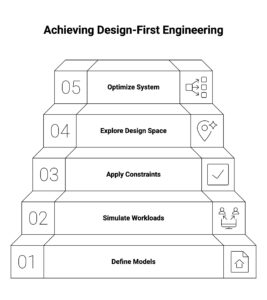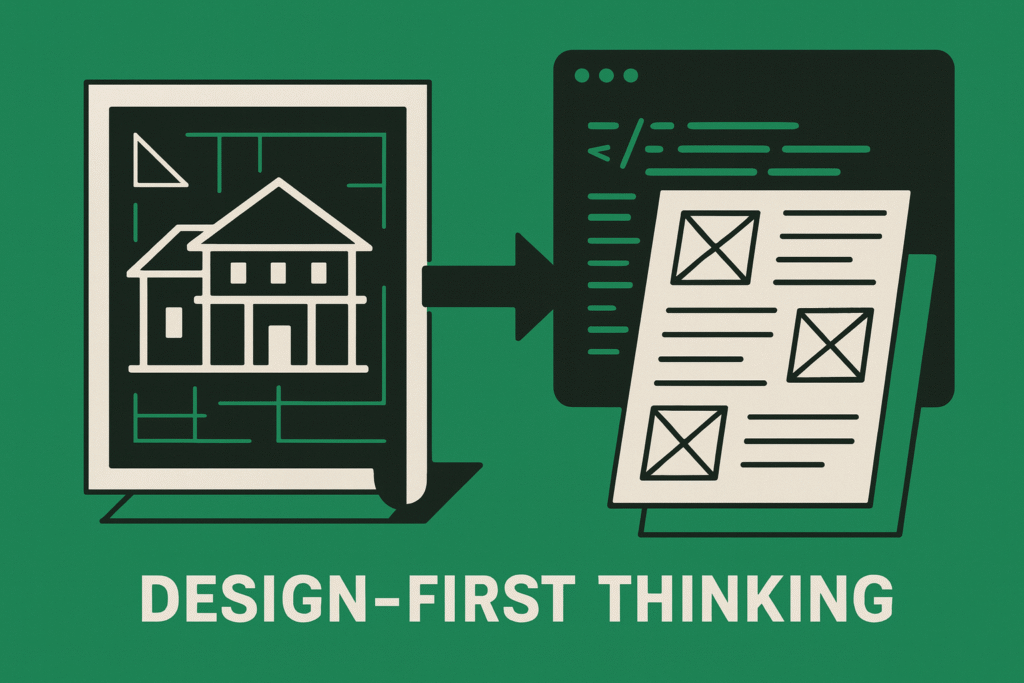Every engineering discipline begins with a thoughtful design process, and software engineering should adopt the same mindset. Just as civil engineers meticulously create validated blueprints before pouring concrete, and chip designers ensure silicon is tested before fabrication, software development teams should invest time in planning before diving into coding.
By prioritizing design, teams can avoid the common pitfalls of code-first projects, which often collapse under production loads. For example, a caching scheme that works well at ten thousand requests per second might fail to perform at a million. Similarly, a storage solution that appears cost-effective at a small scale can unexpectedly double the budget when faced with real workloads.
What starts as “rapid prototyping” can quickly turn into code that later requires extensive re-architecture. Embracing a design-first mentality enables teams to identify potential challenges early and create a more robust foundation, ultimately leading to smoother development and successful project outcomes.
Key Takeaways
- Code-first feels fast, but design-first delivers better, faster: Skipping design leads to costly rewrites; modeling first prevents them.
- Simulation replaces guesswork: Using real workloads and AI-driven optimization, engineers can validate systems before launch.
- Magnition makes design-first practical: Magnition System Designer applies EDA-like (Electronic Design Automation) discipline to distributed systems, ensuring that teams have reliable, scalable, and cost-effective architectures from the start.
Design-first thinking involves modeling, simulating, and optimizing before a single line of production code is written. This approach virtually eliminates conjecture, making performance, scalability, and costs predictable rather than reactive.
Why Code-First Breaks Down in Distributed Systems
Distributed systems serve as perfect examples of the code-first risk. Scope creep starts. Complexity amplifies the cost of every miscalculation. Latency may spike in one region, load balancers break in another, and cloud bills start to soar. By the time these issues are spotted in production, it may be too expensive and potentially too late to resolve.
Code-focused projects often fall into three recurring pitfalls:
- False confidence from prototypes – A small test setup may function well, but the real workload can invalidate initial assumptions.
- Scope creep disguised as progress – “Just add caching” becomes “redesign the storage tier.”
- Hidden costs everywhere – A naive architecture might eventually consume twice the compute and storage budget anticipated.
As a result, teams debate architectural rework, causing deadlines to slip. Reliability suffers as customer-facing issues escalate. And what appeared to be speed in the beginning turns into delay.
What Design-First Looks Like in Practice
Design-first engineering turns guesswork into simulation. It doesn’t start with code; it starts with models, workloads, and constraints.
- Models: Components, from CPUs to distributed storage tiers, are represented with performance and cost characteristics.
- Workloads: Real request traces and traffic distributions, not synthetic averages, drive the simulation.
- Constraints: Service Level Agreements (SLAs), costs, or latency thresholds bound the design space.
From there, you can explore the design, testing thousands of parameter combinations automatically with AI optimizers. Instead of one hand-tuned prototype, the team creates a map of the design space. Which caching strategy holds under peak load? Where does latency spike when workload geography shifts? What configuration balances performance with budget?

This shift results in a significantly different workflow. Code-first and design-first workflows are fundamentally different, as are the results you can achieve.
| Code-First Workflow | Design-First Workflow |
| Start coding a prototype | Start modeling components and workloads |
| Add features until performance breaks | Simulate workloads under scaling conditions |
| Optimize after deployment | Optimize before deployment with AI-assisted search |
| Rewrite architecture under pressure | Validate architecture before coding begins |
| Cost and SLA surprises in production | Cost and SLA certainty before rollout |
Case Study: CDN Optimization with Magnition
Consider the architecture of a content delivery network (CDN). CDNs face competing challenges, including global latency, caching efficiency, and the cost per gigabyte delivered. Code-first teams risk launching with a “good enough” caching solution, despite intending to address any gaps later. Once in production, under the load of real-world applications, good enough is not actually good enough.
Magnition System Designer takes a different approach to this issue. By simulating geographic request distributions, bandwidth variations, and cache eviction strategies, it predicts how a proposed CDN will perform under real-time loads before any production code is written.
When applied to real-world data:
- Wikimedia’s caching strategy showed large improvement potential. Simulation revealed missed optimization opportunities that inflated bandwidth use.
- Cloudflare’s configuration, on the other hand, was already close to optimal, and a design-first analysis confirmed that future growth would not compromise it.
The outcome was predictable: higher cache hit ratios, lower delivery cost, and SLA guarantees validated up front. The code-first path would have found these truths only after customer impact.
From Prototypes to Discipline
Prototypes validate feasibility through modeled scenarios, long before the bill of materials or a line of production code is written. This discipline reframes engineering as a validation process, one that demands evidence before execution.
- Simulation as the Decision Framework – Design choices are driven by validated simulations, where workload, cost, and reliability data replace guesswork and early-code bias.
- Production Code After Validation – Code only follows once the architecture proves itself in simulation for scale, cost, and resilience.
- Long-Term Impact on Delivery – Modeling first prevents late-stage rework, delivering systems faster and more stable by design.
Prototypes are proven before the build, turning design into a measurable discipline. Teams will see better reliability in production and commit fully to the model-first process.
Magniton Drives Design-First Workflows
Magnition System Designer gives engineering teams the tools to make design-first possible. It includes:
- Real workload simulation – Instead of abstract models, teams simulate actual request traces and system traffic.
- AI-driven exploration – Multi-objective optimization evaluates thousands of designs, balancing cost, performance, and reliability.
- Component library – Ready-to-use models of CPUs, networks, memory hierarchies, and storage arrays mean teams don’t start from scratch.
- Scalable simulation engine – Multi-core performance ensures design iteration is fast enough to keep pace with agile cycles.
By embedding these capabilities, Magnition System Designer makes design-first thinking not just philosophy but practice.
Why Design-First Wins
The choice between approaches should be clear. Code-first development may seem fast initially, but it often leads to costly surprises down the line. In contrast, design-first development requires more effort upfront but results in system architectures that scale reliably, meet SLAs, and stay within budget.
In the case of distributed systems, where each decision adds to the complexity, a design-first approach is critical for survival. Adopting design-first thinking restores engineering discipline in software development by validating systems before they are constructed.
With Magnition System Designer, you can stop hoping that your system will scale and start being confident that it will.

